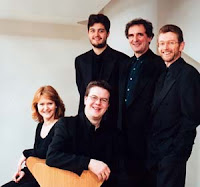 |
| Felix Mendelssohn - View of Amalfi (detail) |
Reviewed by Ruth Hansford on Feb 6 2016
Star rating:
Musical cross pollinations North and South of the Alps in the Nash Ensemble's series Mozart, Mendelssohn and the Italians
This was the sixth concert in the Nash Ensemble's series Mozart, Mendelssohn and the Italians, celebrating musical cross-pollinations North and South of the Alps, at the Wigmore Hall on 6 February 2016. In this programme there was no Mendelssohn, apart from the image of his 1831 painting 'View of Amalfi' on the front of the printed programme booklet (and a few distant echoes in the Verdi quartet), but it certainly put us into a sunny frame of mind on yet another wet and windy Saturday. Instead we had Donizetti's String Quartet No. 13 in A major, Verdi's String Quartet in E minor and Mozart's Clarinet Quintet in A major, K581.
 |
| The Nash Ensemble |
'Haydnesque' is the adjective that first springs to mind. The first movement is gentle and easy-going, the cello providing the pulse while the first violin soars. By the second movement, the adagio, we had a strong sense that Donizetti's future would lie in writing for the voice: downward chromatic phrases anticipating one of his sad (but not unhinged) heroines. The larky minuet was followed by tuneful allegro finale; we were by now squarely in Italy rather than wind-swept London.
In 1873 Verdi was at a loose end in Naples. Rehearsals for Aida had been halted when his leading lady Theresa Stolz fell ill, and 'for mere amusement' Verdi wrote his only mature chamber work, his string quartet in E minor, at the age of 60. The piece was given a private performance but Verdi initially refused to have it published, protesting that the string quartet was a 'non-native plant' on Italian soil. He later allowed the piece to travel north to Paris and the form's Austro-German home, and it was published by Ricordi in 1876.
Inevitably we were on the lookout for echoes from Verdi's operas and we weren't disappointed: the opening E minor movement starts with a melismatic theme reminiscent of some of Amneris' music in Aida. The fact that the second violin (Annabelle Meare) plays this theme gave us a clue too. The second movement Andantino is altogether calmer, and I was put in mind of the ball scene in Un ballo in maschera. The third movement's frantic opening gave way to a lyrical cello tune played mesmerizingly by Adrian Brendel, with pizzicato accompaniment, and the 'Scherzo Fuga' finale anticipated the fugue at the end of Falstaff which Verdi would write 20 years later.
After the interval, a single work, Mozart's Quintet for Clarinet and Strings. Richard Hosford introduced his own basset clarinet as the result of a DIY session, in the tradition of Stadler, Mozart's clarinettist, who had souped up an A clarinet to add four extra notes at the bottom of the range. The added length also gave the instrument a darker tone loved by Mozart and exploited in the Sesto's aria 'Parto, parto' in La clemenza di Tito.
Mozart wrote this quintet in 1789, shortly before Così fan tutte. If we are looking for parallels with the ultimate ensemble opera, we might observe that this was played very much as an ensemble tonight, rather than as a string quartet plus soloist. The darker timbre meant that the clarinet would creep in broodingly and quietly, developing into stunning virtuosic passages showing off the whole range of the instrument. There were duets, too, notably – and divinely – with Laura Samuels on first violin. In fact, everyone gets a turn, and when Lawrence Power's viola solo came in towards the end of the final movement time stood still before the race to the finish.
This was a lovely programme played by consummate musicians clearly enjoying every moment.
Reviewed by Ruth Hansford
Richard Hosford, clarinetLaura Samuel, violin (Donizetti & Mozart)
David Adams, violin (Verdi)
Annabelle Meare, violin
Lawrence Power, viola
Adrian Brendel, cello
Elsewhere on this blog:
- Modified rapture: Chabrier's L'Etoile at Covent Garden - opera review
- Vividly engaging: Vilde Frang, Arcangelo & Jonathan Cohen in Mozart violin concertos - concert review
- Conductors are megalomaniacs! My encounter with Jonathan Lowe - interview
- Powerful and thoughtful: Jonathan Plowright at Rhinegold Live - concert review
- Classical music hyper production conference: my report - conference report
- Gripping theatre: Stuart MacRae and Louise Walsh's The Devil Inside - opera review
- Invigorating Brahms, Dvorak, Shostakovich: Salomon Orchestra at St John's Smith Square - concert review
- Complete Tippett live: Heath Quartet on Wigmore Hall Live - CD review
- Beyond Arcady and Bethlehem: NYCoS National Girl Choir and Karen Cargill in Michael Head - CD review
- A night at the Chinese opera: Zeffirelli's Turandot extravaganza on Metropolitan Opera HD Live with Nina Stemme - opera review
- Magnificent feast: Mozart's Birthday at the Wigmore Hall - concert review
- Home











No comments:
Post a Comment